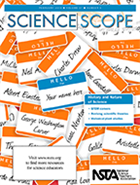History and nature of science
By Mary Bigelow
Posted on 2014-02-08
 If you think that the “history and nature of science” means students reading biographies of scientists of the past, your thoughts may change after browsing this issue of Science Scope. These articles represent lessons that incorporate the past, present, and future of science.
If you think that the “history and nature of science” means students reading biographies of scientists of the past, your thoughts may change after browsing this issue of Science Scope. These articles represent lessons that incorporate the past, present, and future of science.
The History and Nature of Science: Is the Past the Key to Our Future? This question is addressed in a study that compares historical studies to those of today. The focus is on evidence as students examine the concepts of uniformitarianism, catastrophism, and climate change. [SciLinks: Causes of Climate Change]
Science Evolving describes a yearlong exploration of famous life scientists that results in a classroom timeline. The author includes a list of scientists, an example of how to guide students through primary sources, and a photo of the timeline. The activities matched up with the content being studied. [SciLinks: Scientist Biographies]
One misconception students have is that plants absorb food through the roots (I wish that fertilizer and garden ads would stop using the term “plant food”). The author of Historical Plant Studies: Tools for Enhancing Students’ Understanding of Photosynthesis developed a 5e lesson that helps students understand photosynthesis by considering historical studies in botany. The article includes descriptions of these studies and some student-created graphic organizers. [SciLinks: Photosynthesis]
Imagine Darwin’s voyage if present-day technology were available then. Evolutionary Technology: Using Google Earth, Cyber Databases, and Geotagged Photos to Enhance Students’ Scientific Practices and Understanding of Darwin’s Theory of Evolution describes an activity that incorporates Google Earth, cyber databases, and geotagged photos and guides students through defining a problem, locating information, organizing and presenting information, and drawing conclusions. Although we may think of students as digital natives, the authors note that they may have a basic understanding of applications but might not be aware of all of the capabilities. “Teachers may need to create a lesson focused solely on how to use the tool.” But then just watch them! [SciLinks: Charles Darwin, Galapagos Islands, Biological Evolution]
Who would think of using the lowly and annoying housefly to help students understand scientific principles? Don’t Swat That Fly! Using House Flies in an Inquiry Activity embeds the study of adaptations and characteristics of houseflies into a “mystery” to be solved. The article includes a copy of the activity worksheet/directions. [SciLinks: Insects]
Solving a present-day, authentic problem is the focus of Tracking Science: Following the STEM Trend*. After a review of related science concepts, students identified a problem, planned a solution and constructed and tested their trackers. [SciLinks: Seasons, Solar Cells]
The future of science is in our classrooms today, assuming that students choose STEM-related careers. The authors of Career Simulations: Technology Tools That Support STEM Content and Motivation describe several free science simulations that connect science curricula to real-life experiences, such as forensics, neuroscience, and medical research. The URLs of the projects are noted at the end of the article.
Trying to find an alternative to the do-a-report-on-a-career activity? Connecting Students to STEM Careers describes an ongoing STEM career awareness project that ties into curriculum topics. The project consists of 3-5 minute videos and fact sheets on 89 careers (so far). These emphasize technology and engineering, the inclusion of female and minority scientists, opportunities for creativity and problem-solving, and related careers that do not require 4-year or graduate degrees. Talk about going beyond the “mad scientist” stereotype! The authors note that “teachers who do not have a whole day to devote to STEM careers can add video clips to daily or weekly instruction.” I had a day or two in between units for students to catch up on tests and reports. These videos would fit in there.
If you do want to have a career day with guest speakers and other events, Tried and True: How to Organize a STEM Career Day has suggestions for planning, a timeline/checklist, and samples of invitations and schedules. Seeing this gives you an appreciation for what goes into an NSTA conference!
[SciLinks on Careers: Biology, Life Science, Science, Chemistry, Environmental Science, Physics, Engineer, Biomedical Engineer]
*Check out the Connections for this issue (February 2014). Even if the article does not quite fit with your lesson agenda, this resource has ideas for handouts, background information sheets, data sheets, rubrics, etc.
Disclaimer: The views expressed in this blog post are those of the author(s) and do not necessarily reflect the official position of the National Science Teaching Association (NSTA).


